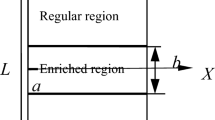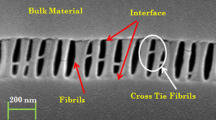Abstract
In order to investigate the crack propagation in quasi-brittle materials like rock, ceramic and concrete, Hillerborg and his co-researchers abstracted the fracture process zone in front of a stress free crack in terms of a “fictitious crack zone”. On the fictitious crack zone, cohesive stresses distribute following a given softening relationship of stress vs. crack opening. Based on the polynomial or power series expression of cohesive crack opening displacement, the relationship of the cohesive stress vs. the crack opening displacement is established using elastic theory and integral equation, and some unknown physics variables are obtained using variation approach. The calculation results gained in this paper are close to the experimentally test ones.
Similar content being viewed by others
References
Lawn, B. R., Fracture of Brittle Solids, UK: Cambridge University Press, 1993.
Hutchinson, J. W., Suo, Z., Mixed mode cracking in layered materials, Advances in Applied Mechanics, 1992, 29: 63–191.
Fan Tianyou, Fracture Theory Principle (in Chinese), Beijing: Science Press, 2003.
Xu Shilang, Zhao Guofan, Researches on the Fracture Mechanics of Concrete, Liaoning: The Press of Dalian University of Technology, 1991.
Issa, M. A. et al., Size effects in concrete fracture (I): experimental setup and observations, International Journal of Fracture, 2000, 102(1): 1–24.
Hillerborg, A., Modeer, M., Petersson, P. E., Analysis of crack formation and crack growth in concrete by means of fracture mechanics and finite element, Cement and Concrete Research, 1976, 6(6):773–782.
Jenq, Y. S., Shah, S. P., Two parameters fracture model for concrete, Journal of Engineering Mechanical, 1985, 111(10):1227–1241.
Bazant, Z. P., Chen, E. P., Scaling of structural failure, Applied Mechanics Review, 1997, 50(10):593–627.
Xu, S. L., Reinhardt, H. W., Determination of double-K criterion for crack propagation in quasi-brittle fracture (I, II and III), International Journal of Fracture, 1999, 98(2):111–193.
Huang Kezhi, Yu Shouwen, Elastic and Plastic Fracture Mechanics, Beijing: Tsinghua University Press, 1985.
Budiansky, B., Amazigo, C. J., Evans, A. G., Small-scale crack bridging and the fracture toughness of particulate-reinforced ceramics, Journal of Mechanics and Physics of Solids, 1988, 36(2): 167–187.
Smith, E., The elastically equivalent softening zone size for an elastic-softening material (I): power law softening behavior, Mechanics of Materials, 1994, 17:363–368.
Rose, L. R. F., Crack reinforcement by distributed springs, Journal of the Mechanics of Physics and Solids, 1987, 35(4): 383–405.
Lin, G., Qi, C. S., Zhou, H. T., An analytical approach of the fictitious crack model for concrete, Engineering Fracture mechanics, 1994, 47(2): 269–280.
Ha Fukuan, Basic of Fracture Physics, Beijing: Science Press, 2000.
Wang Duo, Du Shanyi, Wang Dianfu, Fracture Mechanics, Heilongjiang: The Press of Harbin Institute of Technology, 1989.
Tada, H., Paris, P. C., Irwin, G. R., The Stress Analysis Of Crack Handbook, New York: ASME Press, 2000.
Shen Yidan, Integral Equation, Beijing: The Press of Beijing Institute of Technology, 1992.
Zabreyko, P. P., Koshelev, A. I., Integral Equations: A Reference Text, Leyden: Noordhoff Int. Publ., 1975.
Wang Limin, On solution of integral equation with weak singular kernel of logarithm function, Journal of Shandong University of Technology, 2004, 18(3): 1–7.
Horii, H., Ichinomiya, T., Observation of fracture process zone by laser speckle technique and governing mechanism in fracture of concrete, International Journal of Fracture, 1991, 51: 19–29.
Karihaloo, B. L., Fracture Mechanics and Structural Concrete, England: Longman Scientific and Technical, Longman Group Limited, 1995.
Qian Weichang, Variable Approach and Finite Element Method, Beijing: Science Press, 1980.
Cornelissen, H. A. W., Hordijk, D. A., Reinhardt, H. W., Experimental determination of crack softening characteristics of normal and lightweight concrete, HERON, 1986, 31: 45–56.
Rice, J. R., A path indenpendent integral and the approximate analysis of strain concentration by notches and cracks, Journal of Applied Mechanics, 1968, 35: 379–386.
Li, C., Applicability of J-integral to tension-softening materials, Journal of Engineering Mechanics, 1997, 123(5): 531–533.
Author information
Authors and Affiliations
Corresponding authors
Rights and permissions
About this article
Cite this article
Wang, L., Xu, S. & Zhao, X. Analysis on cohesive crack opening displacement considering the strain softening effect. SCI CHINA SER G 49, 88–101 (2006). https://doi.org/10.1007/s11433-005-0089-5
Received:
Accepted:
Issue Date:
DOI: https://doi.org/10.1007/s11433-005-0089-5




